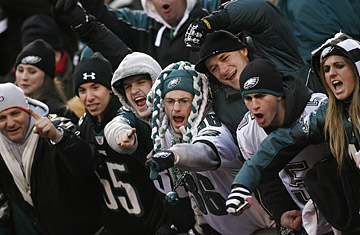
Philadelphia Eagles fans chant and cheer from the stands
With all the attention the Arizona Cardinals and the Pittsburgh Steelers will be getting at this Sunday's Super Bowl, it's not likely anyone will pay much attention to the third team in the stadium. That's hard to figure, since there will be more than 72,000 players on its roster — though they're better known as fans. Whatever else you may say about the hordes of folks whose fannies fill stadium seats, sports fans are in a very real sense a team — one that is in some ways in better synchrony than the athletes on the field. That, at least, is the implication of a new study from Stanford University — one that also concludes that if you want to know how fans become so simpatico, you can start with the National Anthem.
Human beings are naturally skilled at forming groups and communities — which is a very good thing if you want to call yourself a social species. But we often need a little help to find our interpersonal rhythm, and it often comes in ways that involve literal rhythm. Soldiers march and chant. Religions incorporate singing and even dancing in their rituals. Sports events are filled with songs, synchronized cheers, and cries of "DEE-fense." In order to study the power of such collective behaviors, Stanford psychologists Scott S. Wiltermuth and Chip Heath devised a pair of tests. (See pictures of Super Bowl entertainment through the ages.)
In the first, two groups of volunteers were given the straightforward assignment of walking around the Stanford campus. One group was told to walk normally; the other was told to walk in step. In the second experiment, two other groups listened to music through headphones while they moved a series of cups in time to the music they heard. In one group, everyone heard the same music through the headphones, meaning that the cups all moved the same way. In the other, everyone heard different music, making the cups an asynchronous jumble.
Afterwards, both groups were given two money-sharing games to play. The games were different, but both were devised so that the more the participants cooperated, the more they collectively won. In the second of the two games, there was also a rule that allowed individuals to keep more money for themselves, but it would come at the expense of the group haul. As Wiltermuth and Heath anticipated, the groups that had moved in rhythm earlier, cooperated better later — increasing their collective take. Those who moved at their own speed and tempo were likelier to be looking out only for themselves. (See the best and worst Super Bowl commercials of 2008.)
"Synchronous activity," says Wiltermuth, "leads people to feel stronger connections to their group and therefore contribute more to the group's goals."
In a stadium, Wiltermuth explains, this can be more powerful than it seems. The closeness that comes from cheering and rooting together often stays with you when you leave the stadium. "These fans might act more kindly to one another," he says, "and they might be more likely to engage in pro-social behavior such as volunteer tasks, aimed at benefitting the community represented by the team." When Pittsburgh Mayor Luke Ravenstahl playfully changed his name to "Steelerstahl" the week the Steelers met the Baltimore Ravens in the playoffs, he may have had more on his mind than just the Super Bowl. (Read TIME's 1975 cover story on the Pittsburgh Steelers.)
Not all such bonding-by-rhythm is good, as Heath readily admits. Bad-guy armies march too, and rallies that include call-and-response chanting can be used to stop a war ("What do we want? Peace. When do we want it? Now?") as easily as to start one. "Hitler seemed to use synchronous activity in his rallies to bind people," says Heath. "It may have the potential to lead them to commit atrocities."
Barring the occasional burst of soccer hooliganism, sporting events don't have nearly such a dark side, and the players on the field themselves can benefit from a crowd that's on its feet in a communal cheer — hence the famed home-field advantage. So stand up, try not to spill your beer, and feel free to chant yourself raw. Do try to draw the line at the wave, though. All bonding has its limits.
See pictures of the Long, Sad History of Cardinals Football.
See pictures of the New York Giants winning Super Bowl XLII.
